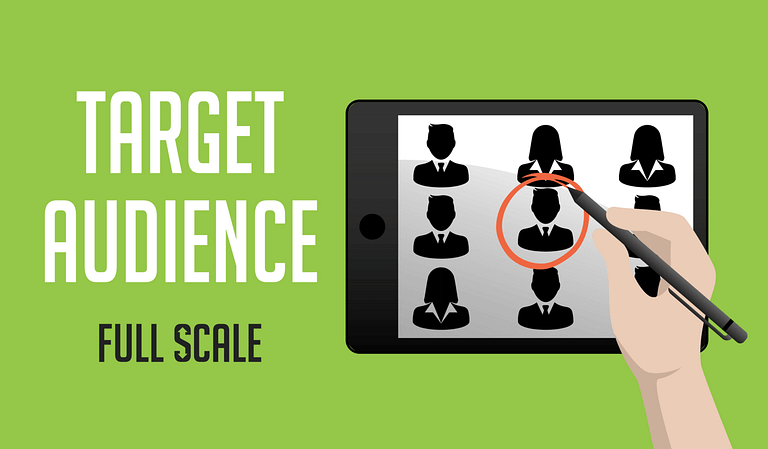Last Updated on 2025-01-13
Reaching your target audience is one of the essential steps to achieving better results with your marketing efforts. In this article, you’ll learn how to target the right audience whom your business needs to focus on.
When you aim to have as many customers as possible, it’s easy to fall into the trap of selling to everyone. One can only assume that having a wider reach means more new customers. But nothing could be further from the truth.
In today’s digital economy, people are constantly inundated by a vast amount of information on a daily basis. Thus, if your message doesn’t target a specific group, it will be dwarfed by all the unfiltered noise and chaos in our surroundings.
Also, if you have a small business, targeting everyone is not only expensive but unproductive. Small businesses can better rival their large competitors when they target a niche market.
Defining your target audience is a cost-effective way to deliver your brand message to the right market, whether it’s through personalized ad campaigns or crafting a professional media kit template for outreach. So, how do you identify your target audience? We’ll show you the steps in this article.
What is a Target Audience?
In a nutshell, a target audience is a distinct group of customers who are likely to respond to your marketing messages. They are classified according to demographic or behavioral categories which include location, gender, age, income level, and purchasing intentions.
If you target a specific audience, your focus is less on the ads themselves, but more on the message. Remember, the language, tone, and content you use to engage with your customers may not be the same in one demographic to another. Finding the right audience will set the best tone and message for customers.
Additionally, creating a target audience profile sets a direction for your marketing strategies and keeps your messaging consistent and relevant. As a result, you build a genuine relationship with customers.
In contrast, if you try to reach everyone, then it is likely that you won’t understand your customers’ needs thoroughly. Remember, the more your customers resonate with you, the more they are likely to become your brand advocate.
Target Market vs. Target Audience
Is target market and target audience the same? While these two terms may be similar, they have key differences as you dig deeper.
Target Market
A target market is a specific consumer segment that a business aims to serve with its products or services. Identifying it is critical when building a product or providing a service. Additionally, your marketing strategies are easier to implement when you have a well-defined target market.
A target market can be divided into categories such as:
- Demographics – age, gender, race, income, marital status, education level, and occupation
- Location – country, region, city, town, time zones
- Psychographics – buyer’s spending habits, values, hobbies, and interests
Let’s use Nivea as an example. Nivea is a German skincare brand that sells shower gel, facial wash, toners, deodorant, lotions, and others. Generally, their target market is a woman, 18-35 years old with mid to high income. These women are self-empowered. They take care of their skin to look good, feel youthful, and boost their confidence.

Target Audience
On the other hand, target audience is narrower in scope than a target market. It refers to a distinct group of consumers that a company targets with its marketing message. They may or may not be your products’ end-users. However, they are the people that you want to appeal to with your marketing efforts. To effectively connect with your target audience, you should know who they are, including their needs and intentions.
To conclude, a target market has a broad implication on every decision that a company makes. Product development, packaging, and pricing decisions are based on what appeals the most to their target market. Moreover, a company’s sales and marketing strategies are based on its target market’s shopping habits and preferences.
Whereas a target audience only has an impact on decisions made on certain marketing messages. Hence, a target market is usually the product’s end users, while a target audience may or may not possibly be.
Different Types of Target Audience
At this point, you already know what a target audience is. Let’s now identify your target audience by considering the attributes that distinguish them from one another. First, you need to look for different types of segments that describe your potential customers. Some of these categories are:
Demography
It refers to a user’s social and economic data. These attributes include gender, age, education, religion, income, and geographic location. If we are to use the demographic data to plan a marketing campaign for young women’s products, you can target females ages 18-26 years old, college-educated, and lives in an urban area with a population of 30,000.
Buyer intention
This is an important data to consider especially for an e-commerce campaign. Your audience can be grouped into users who may not have researched about a specific product (e.g., sports car, 7-kilogram washing machine, dystopian sci-fi thriller film) but are recently looking for them. This allows you to learn about their pain points so you can customize an ad that addresses this need.
Interests and Passion
This refers to your customers’ hobbies, interests, or things they find valuable. These can range from music, personal finance, sports, or parenting. Do they also care about certain issues such as animal cruelty or social responsibility?
By learning about their passions and interests, you have an in-depth insight into your potential customer, which you can use to engage through your brand message.
For example, if you’re a clothing brand that targets the Gen Z crowd, make sure that you market products as ethically-sourced, budget-friendly, and have a positive social and economic impact.
These are just a few examples of the audience types you can target. There are many of them and marketers can create a new type depending on their marketing goals or strategies.
How to Define a Target Audience?
The more detailed you are at defining your target audience, the more effective will the results be for your marketing efforts. Here are practical steps you to take when defining a money-making target audience profile.
Identify their needs and problems
Put yourself in the shoes of your target customers. What could be their problems and needs? What do they expect from your product? Addressing these questions will help you have a deeper insight into them.
Also, it ensures that you’re developing a product or providing a service that has a significant impact on them. So, list down the problems that your target customer might have in their daily lives. Make sure that your products will be able to solve them.
Review existing customers
Check your current customers. See what they have in common. Your loyal customer base may give you an idea of the type of people you should target.
To know what they think about your brand, ask them to join in your surveys or polls in return for some freebies or rewards. This not only helps you to understand them better, but it’s also a great way to build the best marketing campaigns.
Check your competitors
Another way to uncover details about your target audience is to review your competition. Use social listening tools, browse on Google and social media platforms to get a pulse on what your competitors’ target audience looks like.
Take a look at who your competitors are targeting. Assess if their target audience aligns with your business. While doing that, find better ways to fill the gap that’s been missing from their marketing strategies. This allows you to separate yourself from the competition and increase your sales potential.
Refine your target audience
At this point, you already know the benefits your product can offer and what your competitors have been up to. The next step would be to narrow down a particular audience you want to target.
Be precise as much as possible. Identify the demographics of your ideal audience. Segment them according to age, gender, location, etc. Dig deeper into their passions or interests. Do they have hobbies or causes that they are passionate about?
Additionally, see what their intentions are for purchasing a product. Have they researched about this product on the Internet? Once you’ve gathered all the information you need, create a buyer persona. It’s a fictional person that describes your target customer.
Experiment
Finally, it’s time to experiment to see which campaign will work. Create a basic segment and use it on your next campaign. Make sure to regularly track their performance.
Next, build a new segment and include other demographic and psychographic attributes. From there, create a campaign based on the target audience profile you have designed.
Target the Right Audience
In summary, when you try to appeal to everyone, you end up satisfying no one. Selling to every Tom, Dick, and Harry will only get you so far; that is if you ever get past the starting point using this approach.
To survive in a highly competitive market, it’s important to define your target audience. Nowadays, customers don’t simply buy products for the sake of buying. They also expect a branding message that’s unique to their experience. Thus, using sweeping strategies for all customers won’t stay successful in the long haul.
Once you have identified your target market, make sure to provide products or services that validate their needs. Then, work on defining your target audience, the special group that you want to reach with your marketing message. So, be specific and drill down your efforts.
To help you refine your marketing strategies, our team at Full Scale is here to back you up. We have a pool of software developers, graphic designers, project managers, and content writers to work on your startup project.
Ready to get started? Contact us to know more.

Matt Watson is a serial tech entrepreneur who has started four companies and had a nine-figure exit. He was the founder and CTO of VinSolutions, the #1 CRM software used in today’s automotive industry. He has over twenty years of experience working as a tech CTO and building cutting-edge SaaS solutions.
As the CEO of Full Scale, he has helped over 100 tech companies build their software services and development teams. Full Scale specializes in helping tech companies grow by augmenting their in-house teams with software development talent from the Philippines.
Matt hosts Startup Hustle, a top podcast about entrepreneurship with over 6 million downloads. He has a wealth of knowledge about startups and business from his personal experience and from interviewing hundreds of other entrepreneurs.





